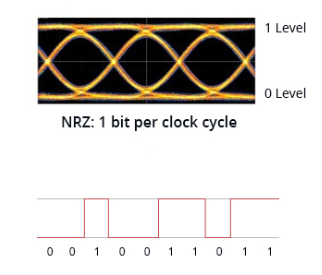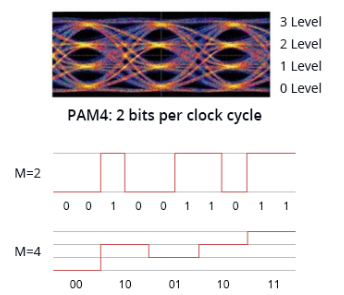
PAM4 (Pulse Amplitude Modulation 4) используется для преобразования цифровых данных в аналоговые сигналы. В 400G Ethernet PAM4 используется для преобразования цифровых данных в оптические сигналы для передачи по оптоволокну. Технология PAM4 представляет 4 различных цифровых состояния путем изменения амплитуды и фазы оптического сигнала, каждое состояние представляет 2 бита данных. По сравнению с традиционной технологией модуляции NRZ (Non-Return-to-Zero), PAM4 может передавать больше данных при той же полосе пропускания, тем самым увеличивая скорость передачи данных. В 400G Ethernet технология PAM4 широко используется для передачи данных между оптическими модулями и оптоволокном.
Преимущества АМ4:
1. Улучшить использование полосы пропускания: PAM4 имеет вдвое большую пропускную способность, чем NRZ, при той же скорости передачи данных, поэтому он может увеличить пропускную способность сети без добавления дополнительных оптических волокон, эффективно улучшая использование полосы пропускания.
2. Уменьшение потерь сигнала: PAM4 позволяет передавать в два раза больше информации за каждый период символа, чем NRZ, поэтому при той же скорости кода скорость передачи данных (скорость передачи символов) PAM4 составляет всего половину скорости сигнала NRZ, что снижает потери сигнала при передаче. Это преимущество позволяет PAM4 использовать существующие каналы и межсоединения для более высоких скоростей передачи данных без увеличения потерь в канале.
3. Сокращение спроса на оптические устройства: PAM4 использует формат модуляции высокого порядка, который позволяет сократить количество используемых оптических устройств и снизить требования к производительности оптических устройств, тем самым снижая затраты.
4. Подходит для встроенных сетей DWDM: оптические модули PAM4 могут напрямую использоваться в коммутаторах встроенных сетей DWDM, предоставляя экономичные и простые решения для клиентов, создающих встроенные сети передачи данных DWDM.
Недостатки PAM4:
1. Ограничение по дальности передачи: оптические модули PAM4 требуют использования усилителей для передачи на расстояние более 5 км, а отдельный мультиплексор DWDM должен быть оснащен компенсацией дисперсии и усилителями, что увеличивает сложность и стоимость системы.
2. Подвержен шумовым помехам: PAM4 восприимчив к шумовым помехам. Его дополнительные требования к уровню напряжения сокращают интервал уровня, что приводит к необходимости более высокого отношения сигнал/шум, особенно при передаче на большие расстояния и в шумных средах, что влияет на качество сигнала.
3. Малое вертикальное глазковое отверстие: вертикальное глазковое отверстие сигнала PAM4 мало, что делает его более чувствительным к шуму и приводит к более высокой частоте битовых ошибок. Однако PAM4 возможен, поскольку прямое исправление ошибок (FEC) может помочь системе достичь требуемой частоты битовых ошибок.
4. Повышенное потребление энергии: для снижения частоты ошибок битов в канале PAM4 необходимо выполнить выравнивание на приемном конце и предварительную компенсацию на передающем конце. Это увеличит дополнительное потребление энергии и выделение тепла, что приведет к увеличению потребления энергии трансивером PAM4.
NRZ (Non-Return-to-Zero) и PAM4 (Pulse Amplitude Modulation 4) — это две разные технологии модуляции, используемые для преобразования цифровых данных в аналоговые сигналы для передачи по оптоволокну. Они отличаются скоростью передачи данных и потерями сигнала.
PAM4 использует 4 различных уровня сигнала для передачи сигнала. Каждый период символа может представлять 2 бита логической информации (0, 1, 2, 3), то есть в одной единице времени есть четыре уровня. Таким образом, при той же скорости передачи данных пропускная способность PAM4 в два раза больше, чем у NRZ. Другими словами, PAM4 может увеличить пропускную способность сети без добавления дополнительных оптических волокон, эффективно улучшая использование полосы пропускания.


Скорость передачи данных: технология NRZ представляет 2 различных цифровых состояния путем изменения амплитуды оптического сигнала, каждое состояние представляет 1 бит данных. По сравнению с технологией PAM4, она представляет 4 различных цифровых состояния путем изменения амплитуды и фазы оптического сигнала, каждое состояние представляет 2 бита данных. Таким образом, технология PAM4 может передавать больше данных при той же полосе пропускания, тем самым достигая более высоких скоростей передачи данных.
Потеря сигнала: технология NRZ может страдать от потери сигнала во время передачи, поскольку амплитуда оптического сигнала может быть ослаблена шумом и затуханием. Технология PAM4 представляет собой 4 различных цифровых состояния путем изменения амплитуды и фазы оптического сигнала, поэтому она может лучше противостоять шуму и снижать вероятность потери сигнала.
